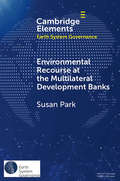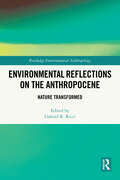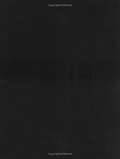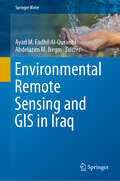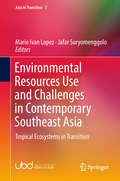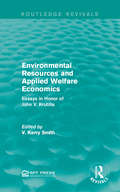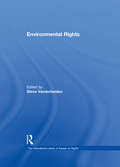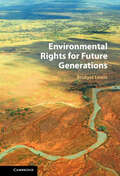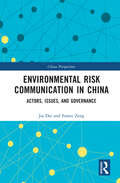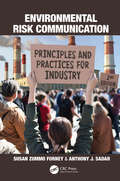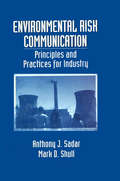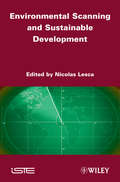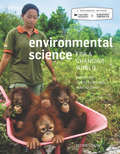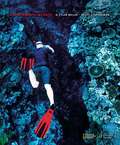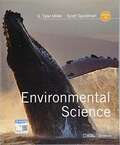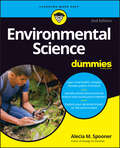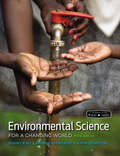- Table View
- List View
Environmental Recourse at the Multilateral Development Banks (Elements in Earth System Governance)
by Susan ParkGlobal governance now provides people with recourse for harm through International Grievance Mechanisms, such as the Independent Accountability Mechanisms of the Multilateral Development Banks. Yet little is known about how such mechanisms work. This Element examines how IGMs provide recourse for infringements of three procedural environmental rights: access to information, access to participation, and access to justice in environmental matters, as well as environmental protections drawn from the United Nations Guiding Principles and the World Bank's protection standards. A content analysis of 394 original IAM claims details how people invoke these rights. The sections then unpack how the IAMs provide community engagement through 'problem solving', and 'compliance investigations' that identify whether the harm resulted from the MDBs. Using a database of all known submissions to the IAMs (1,052 claims from 1994 to mid-2019), this Element demonstrate how the IAMs enable people to air their grievances, without necessarily solving their problems.
Environmental Reflections on the Anthropocene: Nature Transformed (Routledge Environmental Anthropology)
by Gabriel R. RicciIncorporating the intellectual history of disciplines from across the humanities, including environmental anthropology, philosophy, ethics, literature, history, science and technology studies, this volume provides a select orientation to the experience of nature from the ancient world to the Anthropocene.Taking its momentum from the emerging environmental humanities, this collection integrates Western, Indigenous, postcolonial, feminist and eco-spiritual perspectives that address pressing environmental concerns and reimagine the place of humans within the natural world. Across thirteen chapters, the contributors discuss the blending of environmental concerns with political and moral questions and encourage collaborative methods across disciplines to address dialectical tensions between culture and nature. They draw on a wide range of critical perspectives, provide a historical framework and speak to global environmental pressures from multiple standpoints. The global approach adopted throughout highlights the various realities of the growing ecological crisis experienced across the world. Written to appeal to a broad range of readers across the environmental humanities, this edited book will be particularly useful to academics, scholars and researchers in philosophy, anthropology, literature, history and critical theory.
Environmental Regime Effectiveness: Confronting Theory with Evidence
by Edward L. Miles Arild Underdal Steinar Andresen Jorgen Wettestad Jon Birger Skjaerseth Elaine M. CarlinThis book examines why some international environmental regimes succeed while others fail. Confronting theory with evidence, and combining qualitative and quantitative analysis, it compares fourteen case studies of international regimes.
Environmental Regulations and Industrial Competitiveness: Case Studies of Toxic Industries in Southern California (Environment & Policy #62)
by Ward Thomas Paul OngWhile polluting industries in the U.S. continue to emit billions of pounds of toxic chemicals into the air, land and water every year, many economists and policy makers argue that environmental regulations stifle economic growth and reduce the standard of living for the American people. This book takes a fresh look at this question through three case studies of highly regulated polluting industries in the Southern California region: metal finishing, wood furniture, and dry cleaning. The case studies are based on a mix of qualitative and quantitative methods, including in-depth interviews with corporate managers and environmental regulators. The authors find that there is no universal pattern for predicting the effects of environmental regulations on industrial competitiveness, but that the outcomes depend on the structure of the industry being regulated, the design of the regulations, and the technologies that are available for compliance. The book is written in straight forward language that is accessible to the non-economist and will prove an essential resource for academics and students of all levels, and professionals and policy makers in the fields of environmental policy and regional economic development.
Environmental Regulations and Innovation in Advanced Automobile Technologies: Perspectives From Germany, India, China And Brazil (SpringerBriefs in Economics)
by Ashish BharadwajThe book examines innovation in environment-friendly technologies in the automobile industry. The focus of the book are Germany (a technology leader in the global automobile industry), on the one hand, and India, China and Brazil (technologically proficient emerging technology leaders) on the other hand. Patents have been used as a metric to measure and understand innovation. The book traces the evolution of regulatory standards in the automobile industry, relies on a unique patent dataset, and draws on a number of interviews conducted with regulators and engineers to get a better picture of how environmental policies and standards, including emission norms and fuel requirements, have developed overtime and now the industry has responded. The book’s core argument is that technological innovation is what has driven the industry in the past 125 years, but, at the same time, the industry has created problems and faced controversies with regard to its path dependency on carbon-intensive technologies. As a result, we have witnessed growing role of environmental regulators in ensuring that the growth path of the automobile industry, a powerhouse of growth of several economies, is aligned with the larger goals of addressing climate change and energy concerns. Against the backdrop of the emergence of Brazil, China and India in the global economy, the book focuses on the developments in these three countries, and draws parallels with Germany, which benefited from first mover advantage in technology and a substantial head-start in implementing cogent environmental policies. A standardized International Patent Classification (IPC) system has been used to, first, construct an index of regulatory stringency, based on regulations that came about between 1985 and 2010; and second, construct a unique cross-country weighted patent dataset for technologies invented in the past two and a half decades.
Environmental Remote Sensing and GIS in Iraq (Springer Water)
by Abdelazim M. Negm Ayad M. Fadhil Al-QuraishiThis unique book focuses on remote sensing (RS) and geographical information systems (GIS) in Iraq. The environmental applications include monitoring and mapping soil salinity and prediction of soil properties, monitoring and mapping of land threats, proximal sensing for soil monitoring and soil fertility, spatiotemporal land use/cover, agricultural drought monitoring, hydrological applications including spatial rainfall distribution, surface runoff and drought control, geo-morphometric analysis and flood simulation, hydrologic and hydraulic modelling and the effective management of water resources. Also, this book assesses the impacts of climate change on natural resources using both RS and GIS, as well as other applications, covering different parts of Iraq. The book chapters include tens of maps extracted from the remotely sensed datasets, in addition to tables and statistical relations obtained from the results of the studies of the chapters' authors. These studies have been conducted in different parts of Iraq; in the north (Kurdistan region) with its mountainous and undulating lands, in western parts which have desert soils, and in central and southern Iraq where there are salty soils, dunes, wetlands, and marshes.The book is written by distinguished scientists from Iraq, China, USA, Italy, Iran, Germany, and the Czech Republic who are interested in the Iraqi environment. The book is therefore a useful source of information and knowledge on Iraqi environment for graduate students, researchers, policy planners, and stakeholders in Iraq as well as similar regions.
Environmental Resources Use and Challenges in Contemporary Southeast Asia: Tropical Ecosystems In Transition (Asia in Transition #7)
by Mario Ivan Lopez Jafar SuryomenggoloThis edited volume introduces dynamic approaches to the study of Southeast Asia’s environmental diversity from different disciplinary perspectives at the interface between the natural and social sciences. It brings together research on the region’s environmental resource use and shared ecological challenges in the context of present day globalization to offer insights for possible future directions. The book introduces unique approaches to the study of Southeast Asia’s environmental changes and resource management under the influence of intensifying economic change in the region. It also examines the slow erosion of Southeast Asia’s rich environment and addresses serious issues such as the decrease in biodiversity and tropical forests, and the degradation of peat lands. At the same time, it discusses the social issues that are tied to energy-dependent growth and have intensified over the last two decades. It also analyzes the new roadmaps being created to protect, conserve, and manage the environment. By investigating the many ecological issues surrounding us, the volume brings to light the constant struggles we face while trying to develop a more inclusive and equitable approach to natural resources governance. This volume is relevant for students, academics and researchers who have an interest in the Southeast Asian environment and the way in which we use and interact with it.
Environmental Resources and Applied Welfare Economics: Essays in Honor of John V. Krutilla (Routledge Revivals)
by V. Kerry SmithThis book, first published in 1988, provides an overview of the diverse work that was being done in applied and theoretical environmental and resource economics. Some essays reflect upon the background of the work of John Krutilla, one of the founders of Resources for the Future and a leading scholar of environmental economics, and the development of the field to date. Other essays examine and convey findings on particular resource problems and theoretical issues and resource policies and the practice of applied welfare economics. This title will be of interest to students of economics and environmental studies.
Environmental Restoration: Science And Strategies For Restoring The Earth
by John BergerEnvironmental Restoration is the product of a ground-breaking conference on ecological restoration, held in January 1988 at the University of California, Berkeley. It offers an overview from the nation's leading experts of the most current techniques of restoration, including examples of the complex and subtle biological interactions we must understand to ensure success.Chapters cover restoration of agricultural lands, barrens, coastal ecosystems, prairies, and range lands. Additional sections address temperate forests and watersheds, mined lands, soil bioengineering, urban issues including waste treatment and solid, toxic, and radioactive waste management. The book also covers restoration of aquatic systems, includes chapters on strategic planning and land acquisition, and provides examples of successful projects.
Environmental Rhetoric and Ecologies of Place (Routledge Studies in Rhetoric and Communication)
by Peter N. GogginUnderstanding how rhetoric, and environmental rhetoric in particular, informs and is informed by local and global ecologies contributes to our conversations about sustainability and resilience — the preservation and conservation of the earth and the future of human society. This book explores some of the complex relationships, collaborations, compromises, and contradictions between human endeavor and situated discourses, identities and landscapes, social justice and natural resources, movement and geographies, unpacking and grappling with the complexities of rhetoric of presence. Making a significant contribution to exploring the complex discursive constructions of environmental rhetorics and place-based rhetorics, this collection considers discourses, actions, and adaptations concerning environmental regulations and development, sustainability, exploitation, and conservation of energy resources. Essays visit arguments on cultural values, social justice, environmental advocacy, and identity as political constructions of rhetorical place and space. Rural and urban case studies contribute to discussions of the ethics and identities of environment, and the rhetorics of environmental cartography and glocalization. Contributors represent a range of specialization across a variety of scholarly research in such fields as communication studies, rhetorical theory, social/cultural geography, technical/professional communication, cartography, anthropology, linguistics, comparative literature/ecocriticism, literacy studies, digital rhetoric/media studies, and discourse analysis. Thus, this book goes beyond the assumption that rhetorics are situated, and challenges us to consider not only how and why they are situated, but what we mean when we theorize notions of situated, place-based rhetorics.
Environmental Rights (The\international Library Of Essays On Rights Ser.)
by Steve VanderheidenThe essays selected for this volume present critical viewpoints from the debate about the need to establish rights on behalf of greater environmental protection. Three main areas for developing environmental rights are surveyed, including: extensionist theories that link existing rights (for example to subsistence or territory) to threats of harm from exacerbated resource scarcity, pollution or rapid environmental change; proposals for rights to specified environmental goods or services, such as rights to a safe environment and the capacity to assimilate greenhouse gas emissions; and rights that protect the interests of parties not currently recognized as having rights, including nonhuman subjects, natural objects and future generations. This volume captures the potential for and primary challenges to the development of rights as instruments for safeguarding the planet's life-support capacities and features proposals and analyses which argue the need to create an avenue of recourse against ecological degradation, whether on behalf of human or nonhuman right holders.
Environmental Rights for Future Generations
by Bridget LewisThis book presents readers with a new theory and practice of international human rights law that is designed to improve its protection of the environmental rights of future generations. Arguing that international law is currently unable to safeguard future generations from foreseeable environmental harm, Bridget Lewis proposes that the law needs to be reformed in the interests of achieving intergenerational justice. The book draws on different theories of intergenerational responsibility to articulate a fresh approach, revising both substantive principles of environmental rights and procedural rules of admissibility and standing. It looks at several case studies to explore how the proposed new approach would apply in relation to contemporary environmental challenges like fracking, deep seabed mining, nuclear energy, decarbonisation and geoengineering.
Environmental Rights: The Development of Standards (Routledge Explorations in Environmental Studies)
by James R. May Jona Razzaque Owen McIntyre Stephen J. Turner Dinah L. SheltonEnvironmental rights, also known as the human rights or constitutional rights that are used for the protection of the environment, have proliferated over the last forty-five years. However, the precise levels of protection that they represent has since been a major question associated with this phenomenon. Environmental Rights: The Development of Standards systematically investigates this question by analyzing the emerging standards of environmental protection that are associated with such rights and the way that those associations are becoming formalized. It covers all of the relevant human rights treaties to illustrate how environmental rights standards are emerging in this dynamic area. Bringing together an elite group of scholars, this book discusses significant new insights into the way that environmental rights are developing, the standards of protection that they confer, and the way that standards in the field of environmental rights can potentially be further developed in the future.
Environmental Risk Analysis for Asian-Oriented, Risk-Based Watershed Management: Japan And Malaysia
by Minoru Yoneda Mazlin MokhtarThis publication is a practical guidebook on environmental risk assessment, especially for watershed-scale management. It highlights case studies of watershed environmental risk in Malaysia, including the potential health risks as well as screening methods and management in practice. In order to apply environmental risk assessment methods for the management of toxic chemicals, it is necessary to consider the geological and climate features of each country as well as their cultural characteristics. Focusing on Malaysia as a representative country, the book also discusses studies in other Asian countries. The insights provided can be applied to advanced and developing countries alike. A suitable textbook for graduate students, it is also a valuable reference source for researchers, practitioners and policymakers.
Environmental Risk Communication in China: Actors, Issues and Governance (China Perspectives)
by Jia Dai Fanxu ZengThe role of media is becoming increasingly important as globalization has developed. Given fast social transformation and technological development in China, the consequent environmental and health risks demand citizens integrate the communication and prevention of such risks as a significant part of their daily life. This book systematically discusses the communication process of typical environmental risk issues, and the complex interaction among multiple actors, including the public, media, experts, non-governmental organizations, and government in contemporary China. From a media-centered perspective, it applies major theories in the field of enviornmental and risk communication, and uses a variety of empirical research methods to unravel the complicated and unique experience of communication and governance. Combining theoretical reflections with real-life examples of Chinese scenarios, the authors not only encourage a dialogue between Western and Chinese academia but also inspire students and practitioners to apply risk communication theories to solving real-life problems. The book will appeal to students, scholars, and practitioners of risk and environmental communication studies.
Environmental Risk Communication: Principles and Practices for Industry
by Susan Zummo Forney Anthony J. SadarModern industry faces many communication challenges, including social media. The second edition of this book is thoroughly updated, expanded, and reorganized to help industry communicators remain effective in addressing these challenges. At the core of this book are foundational building blocks that address the human factors responsible for driving success or failure when communicating about environmental risk. Features Provides principled guidance for building relationships and engaging in constructive dialogue with stakeholders. Offers straight talk and practical, easy-to-follow guidance on effective risk communication for various situations, stakeholders, and modes of communication. Gives lessons learned from environmental permitting and crisis situations involving risk communication in various industries, including chemical manufacturing, waste management, and the energy sector. Addresses nuanced, recent concerns regarding issues like fake news and social media bullying. Examines the dos and don’ts of communicating effectively during tough conditions like environmental emergencies. Environmental Risk Communication: Principles and Practices for Industry is intended to be both a grounding in enduring principles and a continued resource for best approaches and techniques. Coupled with tools and best practices from decades of experience, this insider’s guide provides CEOs, plant managers, environmental compliance professionals, health and safety officers, and others with the direction and the confidence needed to prepare for difficult dialogue and high-pressure encounters.
Environmental Risk Communication: Principles and Practices for Industry
by Anthony Sadar Mark ShullA public meeting with angry residents and eager reporters is a common feature on the local news. Whether addressing environmental, or other issues, the experience for the board members, consultants, and specialists at these meetings ranges from uncomfortable to nightmarish. The issues discussed in these meetings usually stem from years of community disappointment, mistrust, fears, factions, political or social positioning, or all of the above. Industry faces a labyrinth of environmental and business regulations, and unique challenges in dealing with the public and the media. Environmental Risk Communication serves as a guide to understanding and complying with the Federal Risk Management Program and applying risk management and communication principles to daily plant operations. This book also helps Risk Management Plan (RMP) facilities successfully meet the new Federal requirements for public disclosure of RMP offsite consequence analysis results and provides techniques for communicating effectively during environmental emergencies.Written in a straight-forward, no-nonsense style the book presents concise informative chapters, flow diagrams, checklists, and a thorough index. The authors present step-by-step instruction on developing a principled plan of action that generates open communications. CEOs, Corporate Communications Specialists, Plant Managers, Environmental Compliance Supervisors, Health and Safety Officers, Environmental Scientists and Engineers, and Consultants will benefit from Environmental Risk Communication.
Environmental Scanning and Sustainable Development
by Nicolas LescaThis work is an initial exploration of the relationship between scanning and sustainable development. In ten chapters, the authors examine the application, characteristics and implementation of scanning oriented toward sustainable development. Thus the work offers some answers to the questions “what is sustainable scanning?”, “what new issues does it raise for management practice and management science?”, “what forms can it take?” and “how…?”
Environmental Science
by Anne Houtman Susan Karr Jeneen InterlandiFollowing real people and real science, Environmental Science for a Changing World provides a unique context for showing students how science works and how to think critically about environmental issues. Chapters don't merely include interesting stories--each chapter is an example of science journalism at its best, combining Scientific American-style writing, layout, and graphics to tell one compelling story that exemplifies important concepts and issues. This approach has proven so effective, that instructors using the book report a dramatic increase in the number of students who read the assignments and come to class ready to participate. This updated new edition features new stories, updated scientific coverage, and enhanced Infographics--the book's signature visual study tool that combines memorable images, step-by-step callouts, and now, questions that foster scientific literacy.
Environmental Science (Fifteenth Edition)
by Scott Spoolman G. Tyler MillerAuthors Tyler Miller and Scott Spoolman have partnered with the National Geographic Society to develop a text that will equip you with the inspiration and knowledge you need to make a difference solving today's environmental issues. Exclusive content highlights important work of National Geographic Explorers and Grantees and features over 180 new photos, maps, and illustrations that bring course concepts to life. Using this empowering book, you will learn how nature works, how you interact with it, and how you can use various scientific principles based on how nature has sustained life on the earth for billions of years to live more sustainably.
Environmental Science (Mindtap Course List Series)
by G. Tyler Miller Scott E. SpoolmanThe 16th Edition of ENVIRONMENTAL SCIENCE is "inspiring people to care about the planet." Partnering with National Geographic Learning, the authors Tyler Miller and Scott Spoolman deliver a text that equips and inspires you with the tools and knowledge to make a difference solving today's environmental issues. Exclusive content highlights important work of National Geographic explorers and grantees and features vivid photos, maps and illustrations that bring course concepts to life. Using sustainability as their central theme, the authors emphasize natural capital, natural capital degradation, solutions, trade-offs and the importance of individuals. In return, you learn how nature works, how you interact with it and how humanity can continue to sustain its relationship with the earth by applying nature's lessons to economies and individual lifestyles.
Environmental Science (Tenth Edition)
by Daniel D. ChirasProvides a comprehensive, student-friendly introduction to the environmental issues facing society today and offers numerous solutions for how we can create a more sustainable way of life.
Environmental Science For Dummies
by Alecia M. SpoonerAce your environmental science class and get smart about the environment Environmental Science For Dummies is a straightforward guide to the interrelationships of the natural world and the role that humans play in the environment. This book tracks to a typical introductory environmental science curriculum at the college level—and is great as a supplement or study guide for AP Environmental Science, too. Uncover fascinating facts about the earth’s natural resources and the problems that arise when resources like air, water, and soil are contaminated by pollutants. If you’re in need of extra help for a class, considering a career in environmental science, or simply care about our planet and want to learn more about helping the environment, this friendly Dummies resource is a great place to start. The key concepts of environmental science, clearly explained All about the changing climate, including new understanding of methane release in the arctic Earth’s natural resources and the importance of protecting them A new chapter on environmental justice, where issues of poverty and sustainability intersectA solid foundation in environmental science is essential for anyone looking for a career in the field—and is important knowledge for all of us as we work together to build a sustainable future.
Environmental Science For a Changing World (Third Edition)
by Anne Houtman Susan Karr Jeneen Interlandi<P>Following real people and real science, Environmental Science for a Changing World provides a unique context for showing students how science works and how to think critically about environmental issues. Chapters don’t merely include interesting stories they are examples of science journalism at its best, combining Scientific American-style writing, layout, and graphics to tell compelling stories that exemplify important concepts and issues. This approach has proven so effective that instructors using the book report a dramatic increase in the number of students who read the assignments and come to class ready to participate. <P>This updated new edition features new stories, updated scientific coverage, and enhanced Infographics—the book’s signature visual study tool that combines memorable images, step-by-step callouts, and questions that foster scientific literacy. The book is organized into 11 chapters, each consisting of multiple modules focused on different aspects of environmental science, from ecology and evolution, to human interactions with the environment, to land, water, and energy resources. Although each module tells a compelling and relatable story, it is built on a core pedagogy of Guiding Questions that help students extract the scientific concepts that form the basis for the story.
